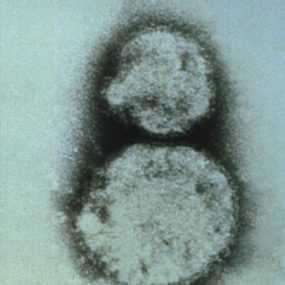Bunyaviridae
The Bunyaviridae are a very large family of single-strand, enveloped RNA viruses (more than 300 viruses) and consists of five genera of viruses: Orthobunyavirus, Phlebovirus, Nairovirus, Hantavirus, and Tospovirus (Tospoviruses infect only plants). They are found in and transmitted by arthropods (e.g. mosquitoes, ticks, sand flies) and rodents, and can occasionally infect humans. Several viruses of the Bunyaviridae virus family can produce mild to severe disease in human, in animals, and sometimes in both. This is the base for the requirements of handling some of these viruses in high containment (Biosafety Level 3 or even Biosafety level 4).
Among the Phleboviruses, Rift Valley fever virus, was first isolated in 1930 as part of a large outbreak among sheep in East Africa. This virus, transmitted by mosquitoes, is endemic (present) in nearly all the countries in sub-Saharan Africa. Human isolated cases and large epidemics (domestic livestock and human) have been described in several countries and even in the Arabic peninsula.
Crimean-Congo hemorrhagic fever (CCHF) virus, of the Nairovirus genus, was first recognized in the Crimean peninsula (in the south of present day Ukraine) in an outbreak of hemorrhagic fever among agricultural workers. The same virus was isolated in 1956 from a single patient in present day Democratic Republic of Congo in Kenya, leading to the actual naming. Although animal and human can be infected, only the later develop a disease. The virus is transmitted by tick, but human-to-human transmission of the virus is very characteristic.
Hantaviruses were first observed in the early 1950’s among troops deployed in the Korean conflict. Eventually named Hantaan virus after the nearby Hantaan River where the human cases occurred, the field mouse (Apodemus agrarius) was discovered to be the specific rodent host for the virus. The disease is actually known as Hemorrhagic fever with renal syndrome (HFRS) and described in the Old World. Following a cluster of cases of severe illness, called Hantavirus pulmonary syndrome (HPS), in the American southwest in 1993, a newly identified virus, called the Sin Nombre virus, was isolated. Related viruses, but responsible for the same clinical disease, are described in the New World (North, Central and South America).

- Page last reviewed: June 18, 2013
- Page last updated: November 14, 2013
- Content source:


 ShareCompartir
ShareCompartir